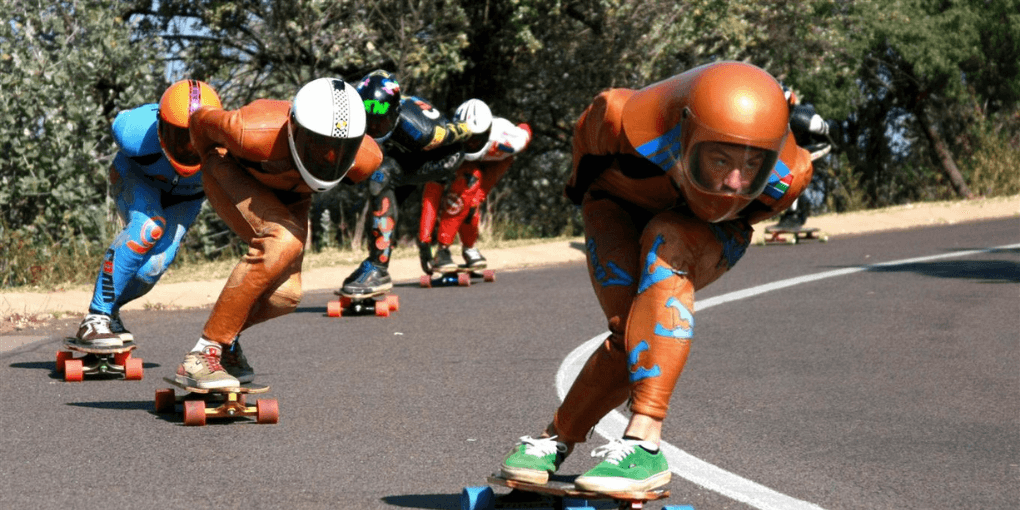Longboard Racing: Thrills, Challenges, and Strategies
Have you ever wondered what it’s like to zoom down hills on a longboard and feel the wind rush through your hair?

Well, let me tell you about the thrilling world of longboard racing!
It’s about mastering techniques, overcoming challenges, and unleashing your inner champion.
As I’ve felt the rush of racing down slopes myself, I can tell you firsthand that it’s an experience like no other.
Legendary skateboarder Tony Hawk once said that the only thing better than the thrill of the ride is the challenge of the race. He’s right!
In this blog, we’ll explore the thrills, challenges, and strategies of racing. We’ll also uncover the secrets behind this thrilling sport.
Get ready to embark on an exciting adventure that will leave you hungry for more!
Know the History of Longboard Racing
By learning about the history, you can understand how this exciting sport has evolved.
- Longboarding’s Beginnings: It started a long time ago. In the early days, people used homemade boards for fun and transportation.
- Surfing Influence: It got its start from surfers. They wanted to bring the feeling of surfing to the land. They used longer boards with bigger wheels to mimic the movements of surfing on waves.
- Skateboarding Evolution: Skateboarding got popular in the 1950s and 1960s. During this time, racing became a way for skaters. They showed off how good they were at riding and how fast they could go.
- Rise of Downhill Racing: In the 1970s, people wanted more excitement and speed in racing. People started racing down steep hills. They competed to see who could reach the bottom the fastest without wiping out.
- Formal Competitions: In the 1990s, longboard racing got more organized. Skaters from all over the world started coming together to race and show off their skills.
- International Recognition: In the 2000s, racing became known around the world. They started making official racing circuits and competitions for professionals. Nowadays, anyone can have fun racing on a longboard. It’s a sport for everyone to enjoy.
- Continued Growth: It keeps improving as new technology and gear emerge. This makes it more fun and easier for people to join in. It’s now one of the coolest and most liked sports worldwide.
Different Types of Longboard Racing
There are different types of racing. Each type of racing offers its own thrills and challenges. Let’s explore them together:
- Downhill Racing: Downhill racing is all about racing down steep hills as fast as you can. You can tuck low to the ground to reduce wind resistance and go even faster. It’s super exciting and can get your heart pumping.
- Slalom Racing: It involves weaving in and out of cones set up on a course. Riders need quick reflexes and good balance to navigate the obstacles.
- Freestyle Racing: It lets you show off your tricks and moves on flat ground or ramps. You can do spins, flips, and slides to impress the crowd. It’s a creative and fun way to express yourself on your longboard.
- Distance Racing: Distance racing is all about endurance and stamina. You can race over long distances and cover many miles. It’s a test of how long you can keep going without getting tired.
- Boardercross: Boardercross combines racing with obstacles and jumps. You can race against each other on a course filled with bumps, jumps, and tight turns.
Essential Equipment for Longboard Racing
By making sure you have the right equipment, you’ll be all set to hit the racecourse and have a blast.
Longboard
The most important thing for racing is, of course, the longboard itself. Longboards are longer and wider than regular skateboards. It gives you more stability and control.
They come in different shapes and sizes. So, you can choose one that feels right for you.
Safety Gear
Safety gear is super important when racing on a longboard. It keeps you safe from falls and bumps. Helmets are a must to protect your head from injury.
Then, you need to put on pads for your knees, elbows, and wrists. They help cushion you if you take a tumble. Gloves can also be helpful to protect your hands and provide extra grip on the board.
Specialized Racing Gear
You can use specialized gear, which will help you go even faster and perform better.
This might include special wheels that are designed for speed and grip. Bearings are also important – they help your wheels spin smoothly.
What Skills and Techniques Are Needed in Longboard Racing?
Practicing these skills and techniques will help you become a confident longboard racer.
- Proper Stance and Balance: You should stand correctly on your longboard. It’ll provide you with stability and control. To stay balanced while racing, keep your feet apart, like your shoulders, and bend your knees a little. This helps you keep your balance and go faster.
- Carving Techniques: It involves making smooth turns by shifting your weight from side to side. To get better at turning, practice leaning into the turns and staying low to the ground. This gives you more control and speed.
- Braking Methods: If you know how to brake, you can control your speed and avoid accidents. You can use your foot to drag along the ground or apply gentle pressure to the tail of the board to slow down gradually.
- Cornering and Crossing Obstacles: Racing courses often have sharp corners and obstacles to cross. You need to learn how to lean into corners. You also need to make quick adjustments to maintain your speed and avoid collisions.
- Drafting and Tactics for Speed: Drafting involves riding closely behind another racer. It helps to reduce wind resistance and conserve energy. You can use drafting strategically to gain speed and overtake opponents. Especially on straight sections of the course.
How to Take Training and Prepare for Longboard Racing
By following these tips, you’ll be well-prepared to tackle the challenges of racing with confidence.
- Physical Fitness: Racing requires good physical fitness. It helps you keep up with the demands of the sport. You can do running, cycling, or swimming to build stability and stamina for long races.
- Mental Preparation: Mental focus and concentration are important for staying calm. It helps you make quick decisions during races. So, you can practice visualization techniques to imagine yourself racing smoothly and confidently.
- Practice Routines: Regular practice sessions are key to improving your racing skills. You can set a time each week to practice different techniques. For example, carving, braking, and cornering in a safe and controlled environment.
- Nutrition and Hydration: To have energy for races, you must eat good food and drink water. You can eat fruits, nuts, and energy bars and drink lots of water before, during, and after races.
What Are the Challenges and Risks of Longboard Racing?
To stay safe while longboarding, you must know about these risks and challenges, take safety steps, and be responsible while riding.
- Safety Concerns: Racing can be risky, especially at high speeds and on challenging terrain. So, you must wear safety gear like helmets, pads, and gloves. These will protect you from falls and injuries.
- Environmental Factors: Weather conditions and terrain can be challenging for longboard racers. Rain, wind, and uneven surfaces can affect traction and control. It makes racing more difficult and dangerous.
- Injury Risks: Falling off a longboard at high speeds can result in injuries like cuts, bruises, and even broken bones. So, you need to be cautious and practice proper safety techniques to reduce the risk of accidents.
- Collision Hazards: Racing courses may have obstacles and other riders that can cause collisions. So, you must stay alert and aware of your surroundings to avoid accidents and injuries on the track.
- Overexertion: Racing needs lots of energy and strength, which can make you feel tired. You need to pace yourself and take breaks as needed to prevent overexertion and burnout.
Know the Strategies for Success in Longboard Racing
By implementing these strategies, you’ll be able to tackle the challenges of racing.
Race Planning
Before the race, you need to consider how you’ll race based on the track and the other racers. You also need to decide where to make your moves and when to conserve energy for the best chance of success.
Course Familiarization
You need to know the racing course before the event by practicing on it or studying maps and videos. Knowing the track well can help you do better in the race.
Positioning Tactics
During the race, stand in a good place to go faster and avoid the wind. If you stay close behind other racers, it can help you save energy and go faster on straight parts of the track.
Cornering Techniques
Mastering cornering techniques is essential for maintaining speed and control through turns.
When you go around corners, lean in and turn smoothly so you don’t slow down. This helps you move around them without losing speed.
Mental Toughness
You must stay focused and confident throughout the race, even in challenging situations.
If you stay strong mentally, it can help you get past problems and keep competing.
What Is the Future of Longboard Racing?
Let’s explore the future of racing together:
- Growing Popularity: Racing is becoming more and more popular around the world. More people are getting interested in the sport and joining races.
- Advancements in Technology: Technology is making longboarding even more exciting. New designs and materials for longboards and gear are being developed. These are making racing faster and safer.
- Increased Accessibility: It is becoming more accessible to people of all ages. Now, there are more opportunities for beginners to learn and practice.
- Community Growth: The racing community is growing stronger every day. More events and competitions are being organized. It’s bringing racers together to share their love of the sport.
- Global Recognition: It is gaining recognition on a global scale. Races are being held in different countries. As a result, more people are tuning in to watch and support their favorite racers.
Know About Racing Safety Measures for Longboard
By following these safety measures, you can enjoy the thrills of longboarding:
Wear Safety Gear
You must wear safety gear during racing time. Your safety gear may include a helmet, knee pads, elbow pads, and gloves. This gear helps protect you from injuries if you fall or crash while racing.
Check Your Longboard
Before racing, you need to check your longboard to make sure it’s in good condition. Also, look for any cracks, loose parts, or signs of wear that could make your longboard unsafe to ride.
Stay Alert
You must pay attention to your surroundings and other racers while on the track.
You also need to watch out for things that could make you fall, like obstacles or changes in the ground.
Follow Race Rules
You have to follow the rules made by the people who organize the race to keep everyone safe.
This means going the right speed, staying in your lane, and being nice to other racers.
Practice Good Sportsmanship
You should show respect to your fellow racers. You must avoid reckless behavior and dangerous stunts that could put yourself and others at risk.
Know When to Stop
If you feel uncomfortable or unsafe while racing, don’t hesitate to stop and take a break. Your safety is the most important thing, so listen to your instincts and take care of yourself.
Conclusion
In conclusion, longboard racing is a fun sport full of thrills, challenges, and plans.
From racing down hills to getting better at turning, it’s a fascinating thing to do.
So, if you want to try longboarding, don’t wait! Grab your longboard and get on the track.
Whether you’re racing against others or trying to beat your own record, the fun of racing is unbeatable.
So, start your own racing adventure now. Have fun and enjoy the ride!
FAQs
Longboarding is a fun and exciting sport where people race against each other on long skateboards called longboards.
Longboard racers can go really fast. Sometimes they reach speeds of over 50 miles per hour when racing downhill!
Yes, anyone who knows how to ride a longboard can take part in racing, no matter their age or skill level.
Longboard races can take place on streets, hills, or specially designed-racing tracks. It depends on the type of race and the location.


